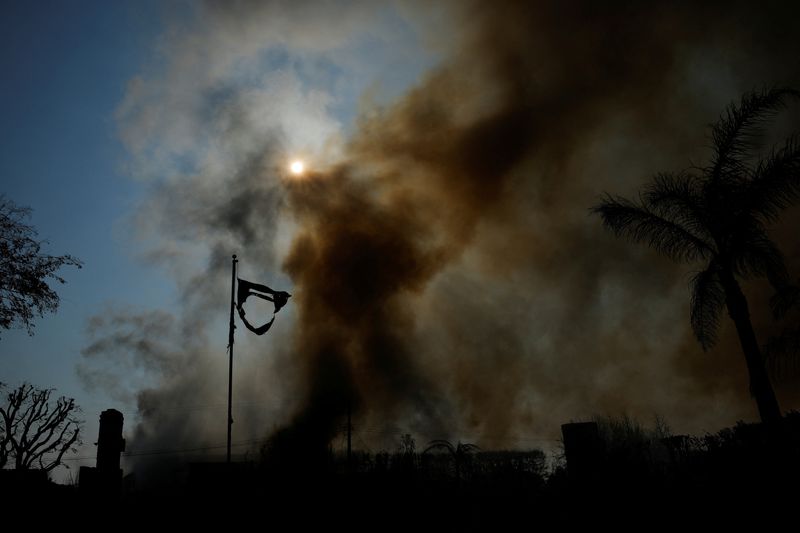By Nancy Lapid
(Reuters) – A number of large wildfires are raging in Los Angeles, blanketing the encircling areas below a pungent haze attributable to smoke carrying noxious gases and particulate matter that pose severe well being dangers.
Here’s what it’s good to know concerning the dangers of the smoke that’s more likely to linger not solely in southern California however in different areas around the globe the place wildfires are burning:
WHAT IS CONTAINED IN WILDFIRE SMOKE?
Extra poisonous than regular air air pollution, wildfire smoke can linger within the air for weeks and journey a whole lot of miles.
Wildfires can burn not solely vegetative supplies and timber but additionally cities, destroying autos and buildings and their contents. Together with particles of soil and organic supplies, wildfire smoke usually comprises traces of chemical compounds, metals, plastics and different artificial supplies.
WHAT ARE THE KNOWN HEALTH EFFECTS?
In laboratory experiments, a given quantity of wildfire smoke causes extra irritation and tissue injury than the identical quantity of air air pollution, based on Kent Pinkerton, co-director of the Middle for Well being and the Surroundings on the College of California, Davis.
Research have linked wildfire smoke with larger charges of coronary heart assaults, strokes, and cardiac arrests, will increase in emergency room visits for respiratory circumstances, and weakened immune defenses. A research in Maryland recognized a spike in coronary heart and lung sicknesses in 2023 that was related to wildfire smoke originating as much as 2,100 miles (3,380 km) away in Canada.
Wildfires even have been linked with eye irritation and pores and skin issues.
The consequences of publicity can persist for years. After Australia’s 2014 Hazelwood Coal Mine fireplace, charges of coronary heart illness remained elevated for 2 and a half years and respiratory sicknesses for 5 years, researchers have reported.
Wildfire publicity in being pregnant has been related to being pregnant loss, low beginning weight, and preterm supply. A research from California discovered a hyperlink between wildfire publicity and mobile injury in first- and second-trimester placentas.
Canadian researchers have reported that individuals who lived outdoors of main cities and inside 50 kilometers (31 miles) of a wildfire previously decade had a 4.9% larger threat of lung most cancers and a ten% larger threat of mind tumors.
Publicity to the 2018 Camp Hearth in California was linked to modifications in cognition and mind exercise six to 12 months later, probably associated to emphasize and trauma, based on California researchers.
Information from California additionally present a rise in fungal infections within the months following wildfire smoke publicity, doubtless attributable to fungal spores within the smoke.
Larger publicity to wildfire smoke can be related to larger odds of creating dementia, based on a research of southern California seniors with out dementia at baseline. Even “a few really severe wildfire smoke days,” with the Air High quality Index over 200, might translate into elevated threat, stated Joan Casey of the College of Washington in Seattle, who led the research.
WHAT IS UNKNOWN?
Extra frequent wildfires doubtless linked to local weather change imply individuals can be uncovered extra usually and the well being results of wildfire smoke publicity over a number of seasons are usually not but clear.
“Repeated exposure is more likely to cause diseases, but it is hard to make predictions because it is hard to say how many fires people will be exposed to, how long the fires will burn, or what the smoke will contain,” stated Keith Bein of the Middle for Well being and Surroundings at UC Davis.
Researchers are additionally wanting into the long-term results of smoke particles in water provides, on crops or ingested by livestock; the long-term results of city wildfire smoke; the results of wildfire publicity in utero on kids’s neurological growth and respiratory outcomes; and whether or not wildfire smoke amplifies the antagonistic results of extraordinarily scorching climate.
Vitamins carried in wildfire smoke might contribute to downwind algal blooms, which has implications for ingesting water reservoirs and lake ecology, researchers warn.
WHAT CAN HELP MITIGATE THE RISKS?
Specialists say it’s best to restrict outside actions, particularly strenuous sports activities, and to put on N95 masks when wildfire smoke is current.
A web-based course with directions for decreasing outside and indoor publicity to wildfire smoke is offered from the U.S. Environmental Safety Company.

DO WE REALLY NEED TO WORRY?
Doug Brugge, who chairs the Division of Public Well being Sciences at UConn College of Medication, stated wildfire smoke might be lethal. “People should… reduce their exposure, especially if they are in a vulnerable population, such as the elderly, young children or people with respiratory diseases.”




